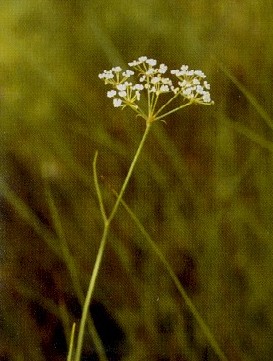Tiedemannia canbyi facts for kids
Quick facts for kids Tiedemannia canbyi |
|
|---|---|
 |
|
| Conservation status | |
| Scientific classification | |
| Genus: |
Tiedemannia
|
| Species: |
canbyi
|
Tiedemannia canbyi is a special flowering plant. It is also known as Canby's dropwort or Canby's cowbane. This plant belongs to the carrot family. You can find it in the southeastern United States. It grows along the Atlantic coastal plain from North Carolina to Georgia. It also lives near the Chesapeake Bay. This plant is in danger because its wetland homes are disappearing. Because of this, the United States government lists it as an endangered species.
What Does Canby's Dropwort Look Like?
This plant is a perennial herb. This means it lives for more than two years. It grows from underground stems called rhizomes. It can grow up to 1.2 meters (about 4 feet) tall. Its leaves are thin and hollow, like quills.
The plant's flowers grow in a cluster called an inflorescence. This cluster looks like an umbrella, known as a compound umbel. Each flower is small with white petals. They also have green parts called sepals that are tinged with red. Canby's dropwort usually blooms in August and September. Sometimes it blooms into October. The plant smells a bit like dill.
Its stems can spread along the ground. These spreading stems are called stolons. They can grow roots at different points. This helps the plant create a large group of new stems. All these new stems are part of the same plant. This way, it can spread and grow without needing seeds. This is called vegetative reproduction.
Canby's Dropwort and Its Friends
The young forms, or larvae, of the black swallowtail butterfly (Papilio polyxenes asterius) like to eat this plant. They munch on the stems. Sometimes they eat the flower clusters. This can stop the plant from making seeds.
However, Canby's dropwort often makes new plants in another way. It uses cloning. This means it makes exact copies of itself. It does this more often than making seeds.
Why Is Canby's Dropwort Endangered?
Scientists have found about 53 groups of this plant. Most of them are in South Carolina and Georgia. There is one group in Maryland and one in North Carolina. Sadly, this plant has completely disappeared from Delaware. Most of the groups that are left are quite small.
Canby's dropwort grows in different types of wet areas. These include bays, sloughs, wet savannas, and ponds. Many other plants also grow in these habitats.
The biggest danger to Canby's dropwort is the damage to its home. Wetlands along the southeastern US coast have been changed. People have dredged them, drained them, or used them for farming. This includes growing trees for wood, called silviculture. These changes affect how water moves in the area. This includes water on the surface and underground water. These changes then harm the plants.
Sometimes, shrubs grow too much in these areas. They can block the sunlight. Canby's dropwort needs open, sunny places to grow best. It does not like shade. To help the plant, people have removed some shrubs and trees. These include sweetgum (Liquidambar styraciflua) and persimmon (Diospyros virginiana). This helps the dropwort get enough sunlight to thrive.


